TI
RSP 11149
Grower: PhytaTech
General Information
- Accession Date
- May 7, 2019
- Reported Plant Sex
- not reported
- Report Type
- StrainSEEK v2 3.2Mb
- DNA Extracted From
- Stem
The strain rarity visualization shows how distant the strain is from the other cultivars in the Kannapedia database. The y-axis represents genetic distance, getting farther as you go up. The width of the visualization at any position along the y-axis shows how many strains there are in the database at that genetic distance. So, a common strain will have a more bottom-heavy shape, while uncommon and rare cultivars will have a visualization that is generally shifted towards the top.
Chemical Information
Cannabinoid and terpenoid information provided by the grower.
Cannabinoids
No information provided.
Terpenoids
No information provided.
Genetic Information
- Plant Type
- Type III
File Downloads
The bell curve in the heterozygosity visualization shows the distribution of heterozygosity levels for cannabis cultivars in the Kannapedia database. The green line shows where this particular strain fits within the distribution. Heterozygosity is associated with heterosis (aka hybrid vigor) but also leads to the production of more variable offspring. When plants have two genetically different parents, heterozygosity levels will be higher than if it has been inbred or backcrossed repeatedly.
The ratio of reads mapped to Y-contigs to reads mapped to the whole Cannabis genome (Y-ratios) has been demonstrated to be strongly correlated with plant sex typing. This plot shows the distribution of Y-ratios for all samples in our database which were sequenced with the same method (panel or WGS) as this sample and where this sample falls in the distribution.
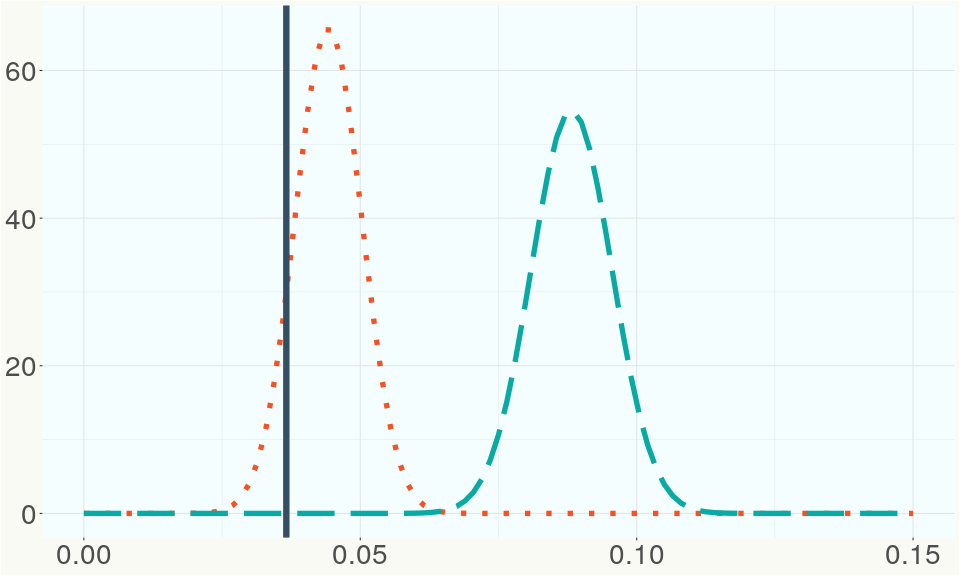
This chart represents the Illumina sequence coverage over the Bt/Bd allele. These are the three regions in the cannabis genome that impact THCA, CBDA, CBGA production. Coverage over the Active CBDAS gene is highly correlated with Type II and Type III plants as described by Etienne de Meijer. Coverage over the THCA gene is highly correlated with Type I and Type II plants but is anti-correlated with Type III plants. Type I plants require coverage over the inactive CBDA loci and no coverage over the Active CBDA gene. Lack of coverage over the Active CBDA and Active THCA allele are presumed to be Type IV plants (CBGA dominant). While deletions of entire THCAS and CBDAS genes are the most common Bt:Bd alleles observed, it is possible to have plants with these genes where functional expression of the enzyme is disrupted by deactivating point mutations (Kojoma et al. 2006).
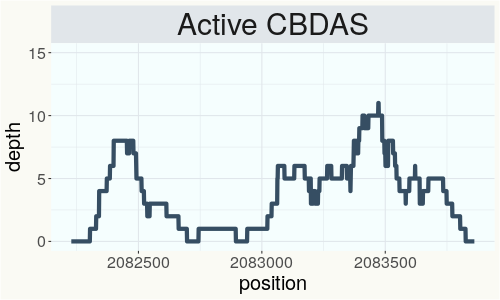
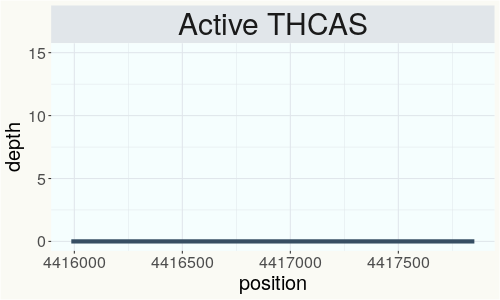
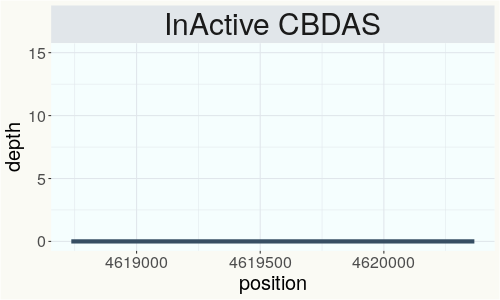
This chart represents the Illumina sequence coverage over the CBCA synthase gene.
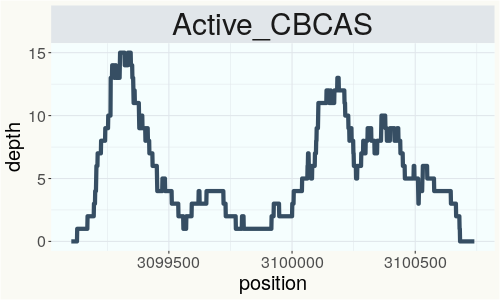
Variants (THCAS, CBDAS, and CBCAS)
No variants to report
Variants (Select Genes of Interest)
| PKSG-2b | c.1152T>A | p.Asn384Lys | missense variant | moderate | contig700 | 1950486 | A/T | |
| PKSG-2b | c.1132C>G | p.Leu378Val | missense variant | moderate | contig700 | 1950506 | G/C |
|
| PKSG-2b | c.1117A>G | p.Ile373Val | missense variant | moderate | contig700 | 1950521 | T/C | |
| PKSG-4b | c.496A>G | p.Lys166Glu | missense variant | moderate | contig700 | 2721177 | T/C | |
| PKSG-4b | c.489delT | p.Phe163fs | frameshift variant | high | contig700 | 2721183 | CA/C | |
| PKSG-4b | c.485A>G | p.Lys162Arg | missense variant | moderate | contig700 | 2721188 | T/C |
Nearest genetic relatives (All Samples)
- 0.091 Rest (RSP11377)
- 0.093 Trump x Trump (RSP11466)
- 0.164 T S A G E (RSP11351)
- 0.166 Queen Dream (RSP11289)
- 0.176 Wilburs Great Adventure (RSP11727)
- 0.183 Danny Noonan (RSP11070)
- 0.186 Queen Dream (RSP11288)
- 0.188 Hermaphrodite Research Sample1 (RSP11042)
- 0.188 Queen Dream CBG (RSP11280)
- 0.191 Hermaphrodite Research Sample1 (RSP11049)
- 0.195 Blue Dream (RSP11017)
- 0.196 Bordello (RSP11228)
- 0.204 QQD2 (RSP11450)
- 0.208 Electra (RSP11366)
- 0.210 Blueberry Cheesecake (RSP10684)
- 0.214 Queen Dream (RSP11278)
- 0.215 Super Blue Dream (RSP11011)
- 0.215 MBD (RSP11368)
- 0.216 Blue Dream (RSP11009)
- 0.216 Blue Dream (RSP11006)
Most genetically distant strains (All Samples)
- 0.478 Cherry Blossom (RSP11317)
- 0.460 Cherry Blossom (RSP11328)
- 0.445 Unknown--Cherry Wine---003- (RSP11270)
- 0.443 80E (RSP11213)
- 0.442 Cherry Blossom (RSP11309)
- 0.440 Cherry Blossom (RSP11311)
- 0.435 80E (RSP11211)
- 0.430 Tiger Tail -30- (RSP11484)
- 0.426 Unknown--Cherry Wine---002- (RSP11269)
- 0.424 CS (RSP11208)
- 0.423 Cherry Blossom (RSP11314)
- 0.422 Feral (RSP11205)
- 0.421 Feral (RSP11206)
- 0.418 Carmaleonte (RSP11207)
- 0.418 JL 3rd Gen Father (RSP11196)
- 0.418 Unknown--Cherry Wine---001- (RSP11268)
- 0.418 Cherry Blossom (RSP11298)
- 0.414 Unknown--Cherry Wine---004- (RSP11271)
- 0.414 Cherry Blossom (RSP11333)
- 0.414 Beniko (SRR14708275)
Nearest genetic relative in Phylos dataset
- Overlapping SNPs:
- 121
- Concordance:
- 77
Nearest genetic relative in Lynch dataset
- Overlapping SNPs:
- 5
- Concordance:
- 5
Blockchain Registration Information
- Transaction ID
-
8fcc47c323a71a25
6ac684ef5f06d275 29ddbdf9dfaa7ab1 fd1f3e73844ab836 - Stamping Certificate
- Download PDF (855.6 KB)
- SHASUM Hash
-
106815a8262d7f92b6d1501fbf9dcf21 9770b6df9d0bb74d 2c82f9c63fa4ae63